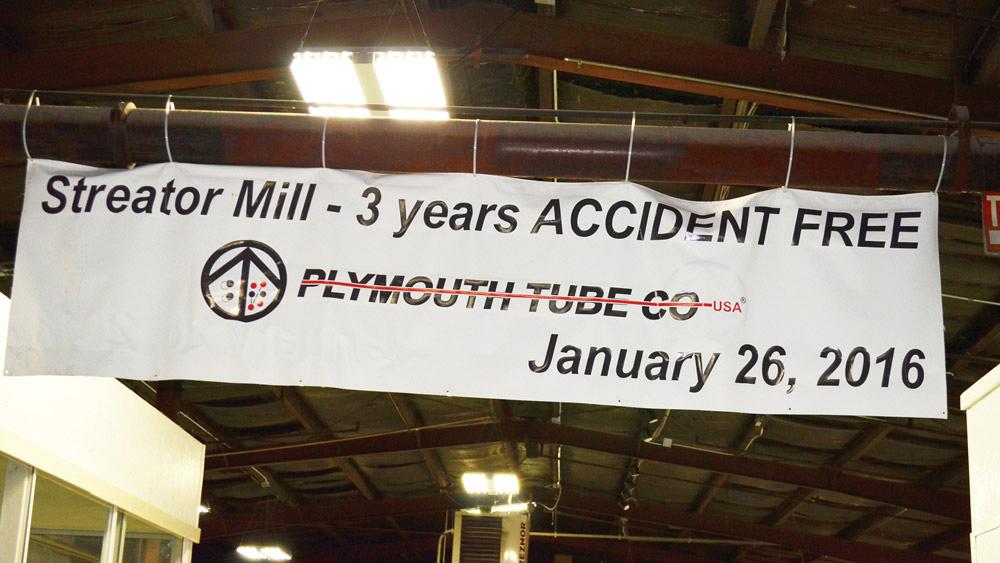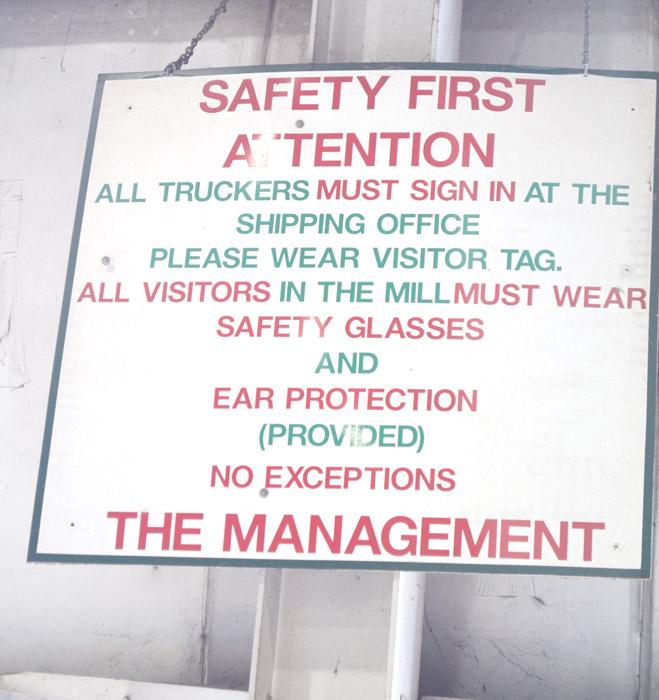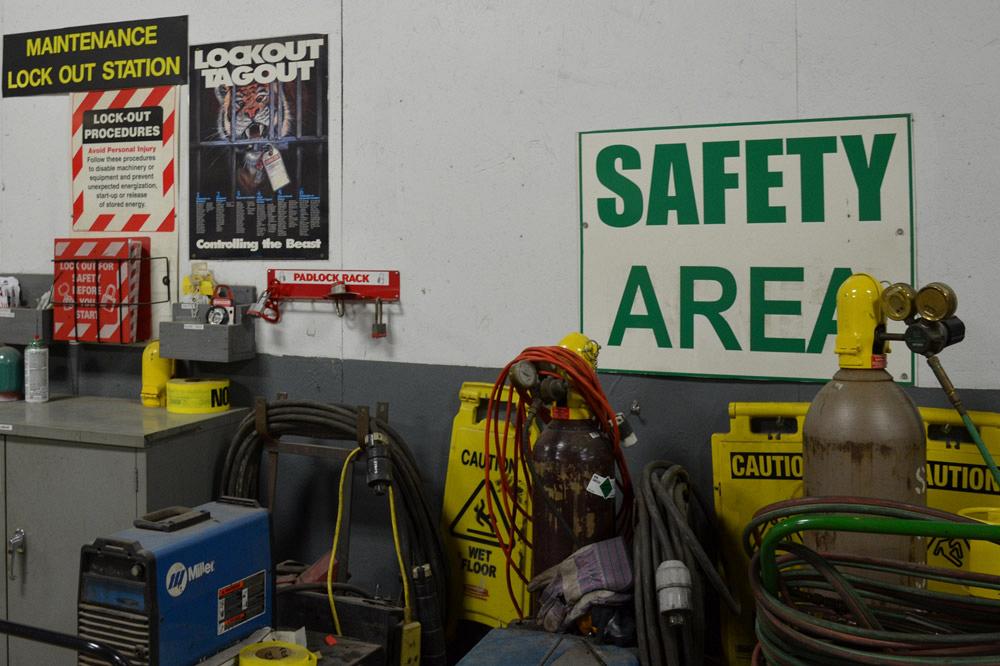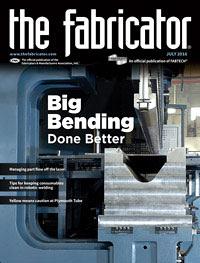Editor-in-Chief
- FMA
- The Fabricator
- FABTECH
- Canadian Metalworking
Categories
- Additive Manufacturing
- Aluminum Welding
- Arc Welding
- Assembly and Joining
- Automation and Robotics
- Bending and Forming
- Consumables
- Cutting and Weld Prep
- Electric Vehicles
- En Español
- Finishing
- Hydroforming
- Laser Cutting
- Laser Welding
- Machining
- Manufacturing Software
- Materials Handling
- Metals/Materials
- Oxyfuel Cutting
- Plasma Cutting
- Power Tools
- Punching and Other Holemaking
- Roll Forming
- Safety
- Sawing
- Shearing
- Shop Management
- Testing and Measuring
- Tube and Pipe Fabrication
- Tube and Pipe Production
- Waterjet Cutting
Industry Directory
Webcasts
Podcasts
FAB 40
Advertise
Subscribe
Account Login
Search
Yellow: The color of safety awareness
Visual reminders keep safety at the forefront at Plymouth Tube's Streator, Ill., facility, the winner of FMA’s 2016 Rusty Demeules Award for Safety Excellence.

Figure 1
This banner, hanging in Plymouth Tube’s Streator, Ill., tube forming facility, reminds workers that they have been able to work almost 200,000 hours without experiencing an injury that requires an OSHA report.
“It’s nice to see so much yellow around.”
I said it almost without thinking as I walked around Plymouth Tube’s Streator, Ill., facility in mid-May. Jamie Derossett, a supervisor in charge of quality, environmental, and safety efforts, was acting as the tour guide, pointing out all the potential areas where an employee could get in trouble very quickly. Those trouble spots were easy to locate after all: They were colored yellow. (For examples, see the Visualizing Safety sidebar.)
The Streator facility is where Plymouth Tube makes small-diameter tube products. Streator workers start with steel hollows made from carbon and alloy seamless steel tubing and use specially designed equipment to cold-draw them into special diameters. They also can prepare special shapes, such as squares, rectangles, and teardrop, for certain applications. As Plant Manager Larry Keith put it, “Just because you have this equipment doesn’t mean that you can do what we do with this tubing.”
The Streator facility does quite a bit with the tubing, creating ample opportunity for something to go wrong. Consider the material: In most instances, the steel hollows are long and small diameter, which can lead to difficulty in moving and controlling the material as it makes its way through work processes. Derossett said that employees trying to handle the material shift after shift and day after day can lead to a higher risk of sprains and strains.
“Some tubes are heavy and others are so small they become tangled,” she said.
Then consider the processes themselves: The facility has a multistage pretreatment system that cleans the steel hollows and applies a lubricant to them prior to cold drawing; several cold-drawing lines where one end of the steel hollow is clamped and mobile forming tooling travels the length of the hollow to create the specified diameter and shape; a furnace where the tubes are heated to remove some of the hardening characteristics created by the cold-forming process; a couple of multiprocess lines where the formed tubes are straightened, scanned for flaws, and cut to length; and a material staging and shipping area. When production is humming, the facility is abuzz with activity.
In the past when the company was busy, unfortunately, injuries often occurred, according to Derossett. It was only about a decade ago that Plymouth Tube might log at least 20 injuries per year requiring OSHA reports. Safety was not a priority—at least at that time.
Over the last several years, however, Plymouth Tube has gotten serious about safety in its nine locations, including the corporate office. Audits are being conducted, and best practices are being shared among the plants.
In Streator, Derossett said regular discussions about safety, investments to make the workplace safer, and some changeover in the employee ranks helped a more safety-conscious environment develop. With more awareness came fewer OSHA-recordable injuries. When injury-free days began to stack up, employees became more interested in keeping the streak alive (see Figure 1). As of mid-May, Plymouth Tube’s Streator location had gone 1,206 days without an OSHA-recordable injury. That’s a corporate record, and the shop continues to prolong the streak. That turnaround and the company’s continued commitment to keeping its employees safe have helped Plymouth Tube earn the 2016 Rusty Demeules Award for Safety Excellence from the Fabricators & Manufacturers Association.
The Daily Reminder
Every shift at the Streator tube production facility begins with a quick five- to 10-minute meeting in a well-lit area of the plant (see Figure 2). The supervisor leads a discussion about issues from the day before, production goals for the current day, review of cycle time performances, and other production-related metrics.

Figure 2
Each shift at Plymouth Tube’s Streator facility meets in this space to review pertinent production information and stretch to prepare for the day’s mental and physical challenges.
But this time is not totally dedicated to a production update. People stretch as well.
The stretching is a reflection of the employees’ taxing responsibilities on the shop floor, Derossett said. Reaching, pulling, and trying to control small-diameter tubing can be strenuous, so the stretching is meant to loosen up employees’ muscles for the day’s tasks.
The supervisor leads the stretching. The instructions are posted in the gathering area for those that might be new to the exercises. The entire stretching effort lasts about two minutes.
Derossett admitted that when the company asked employees to start stretching about two years ago, plenty of people were skeptical of the effort. Some joined in, while others just watched. Soon, however, everyone joined in. Today a site-specific safety program encourages participation.
The Company Safety Program
That safety program has been in place since 2008. It encourages employees to participate in certain activities, earning them credit that can result in a monetary incentive.
The safety program requires employees to earn two points each month if they wish to earn the incentive. Participation in daily stretching can be one of those points. Other ways to earn a point are participating in a safety meeting; filling out a safety observation report (which is required at four times per year); participating in a continuous improvement event that covers a safety concern; and community service, such as serving as a baseball coach or completing emergency medical training.
If an employee earns two points for the month, he or she receives a corresponding boost in the paycheck. Derossett keeps tabs of who has done what to qualify for the incentive.
“This is not influenced by OSHA recordables, so we aren’t penalizing for getting a recordable,” she said. “An employee can have a recordable, and he or she can expect the incentive if they still meet the requirements.”
Derossett said that this has been a good exercise in getting everyone involved.
“We always used to have safety tours and safety meetings, but I would get five people to show up,” she added. “Now I make it a part of the safety engagement, and I get the whole shift there.”

Figure 3
Safety rules apply to everyone that sets foot on the Plymouth Tube campus, including visitors.
Companywide Sharing of Information
Best practices that work in one Plymouth Tube facility aren’t kept a secret. Corporate headquarters ensures that the successes are shared with the entire organization.
The corporate safety official often shares pictures of what he considers to be a noteworthy safety improvement in the plants. The picture is then sent to the safety managers at the different company locations. That information then becomes a topic at a safety meeting.
Even if the picture doesn’t exactly apply to the location, Derossett said she still discusses the photo because a general lesson can be learned. For example, when a recent photo showed a good example of guarding on a piece of equipment that the Streator facility doesn’t have, Derossett still stressed the importance of avoiding a pinch point or “staying out of the line of fire.”
Additionally, when an OSHA-recordable injury occurs at any facility, a form is filled out and shared with all the safety managers. Again, the scenario that led to the accident can be discussed in safety meetings and addressed in follow-up actions.
Staying on Top of Safety Improvements
A safe work environment is not sustained simply by holding meetings and sharing information. Like anything worth improving, safety efforts at Plymouth Tube in Streator are analyzed on a regular basis to determine if safe practices are being adhered to and if any plant changes have created a scenario that might affect employees’ safety or health.
The Streator facility is audited regularly to keep tabs on its safety environment. For the past several years, the plant has relied on an area consultant to provide an overview on an annual basis. Derossett said the company invited an Illinois Valley Community College representative to conduct a similar audit to provide an alternative point of view.
The corporate safety director also performs a safety audit that follows the guidelines of ISO 18001. (The company is not formally ISO 18001-certified.) The audit looks at safety planning and risk assessment; safety training and awareness; communication of safety news; and continuous improvement efforts.
Derossett said that anything that comes up as a result of those audits is worked into an action item for weekly meetings of other supervisors. At that Monday meeting, the team can decide how to address the improvement needs identified by the safety audit. That action item remains on the agenda for future meetings until it is resolved to everyone’s satisfaction.
Trying to Extend the Streak
Five years ago, the Plymouth Tube corporate management staff launched its President’s Award competition that presented awards to the locations that met certain safety goals. The Streator plant has won an award for each of the last three years because it hasn’t had any noteworthy injuries. It has several thousands of dollars waiting to be spent on further safety improvements as a result of winning the award; it just needs to figure out how to spend the money.
The transition from a production environment where the next major injury was almost expected to one where people are being extra careful to keep the injury-free streak going has been a major one. Workers’ compensation costs for the Streator facility are at the lowest level in recent memory, and people are buying into the idea that preventing accidents (see Figure 3) is a lot better than simply reacting to an injury and hoping that it doesn’t occur again.

Visualizing Safety
Notice the safety caps on the gas cylinders.
If a cylinder should fall and make contact with the floor or some other object, the safety cap ensures the connector isn’t knocked off, preventing the release of gases into the facility.
“Everyone in the company is surprised that we have come so far,” Derossett said. “For them to now come see us on tours and see what we are doing, that is really a credit to everyone here.”
Who is Rusty Demeules?

Rusty Demeules
The Fabricators & Manufacturers Association’s Award for Safety Excellence, which is sponsored by CNA, is named after a very important person in the association’s history. Rusty Demeules, who worked for his family’s metal fabricating company, Standard Iron and Wire Works, in Monticello, Minn., served as president of the FMA/CNA Safety Committee from its inception in 1989 until 1996. He also served seven years on the FMA board of directors from 1983 to 1989.
During his time on the Safety Committee, Demeules worked to develop the FMA-sponsored insurance program that is tailored for fabrication companies and tool- and diemaking shops. CNA has been FMA’s endorsed business insurance provider for more than 20 years.
When Demeules stepped down from his role on the Safety Committee in 1996, he also retired
as president of Standard Iron and Wire Works. That same year FMA honored Demeules with its Chairman’s Award for his service to the industry and the association.Applications for the Award for Safety Excellence are accepted each year during January and February. The winning company receives:
- Complimentary registration and travel expenses for a company representative to attend FMA’s Annual Safety Conference.
- An engraved, crystal award to be presented to the representative at the Safety Awards dinner at the conference.
- A safety training package of relevant resources from the FMA Store.
- Recognition in FMA publications.
The award is presented at the annual spring FMA Safety Conference.
Visualizing Safety
One of the best ways to make employees and visitors to a facility aware of potential injury situations is to make them aware of dangerous areas. At Plymouth Tube’s Streator, Ill., operation, yellow is used to signify areas where people need to be aware of their surroundings. It also represents investments that have been made to keep employees safe.
About the Author

Dan Davis
2135 Point Blvd.
Elgin, IL 60123
815-227-8281
Dan Davis is editor-in-chief of The Fabricator, the industry's most widely circulated metal fabricating magazine, and its sister publications, The Tube & Pipe Journal and The Welder. He has been with the publications since April 2002.
Related Companies
subscribe now

The Fabricator is North America's leading magazine for the metal forming and fabricating industry. The magazine delivers the news, technical articles, and case histories that enable fabricators to do their jobs more efficiently. The Fabricator has served the industry since 1970.
start your free subscription- Stay connected from anywhere

Easily access valuable industry resources now with full access to the digital edition of The Fabricator.

Easily access valuable industry resources now with full access to the digital edition of The Welder.

Easily access valuable industry resources now with full access to the digital edition of The Tube and Pipe Journal.
- Podcasting
- Podcast:
- The Fabricator Podcast
- Published:
- 04/16/2024
- Running Time:
- 63:29
In this episode of The Fabricator Podcast, Caleb Chamberlain, co-founder and CEO of OSH Cut, discusses his company’s...
- Industry Events
16th Annual Safety Conference
- April 30 - May 1, 2024
- Elgin,
Pipe and Tube Conference
- May 21 - 22, 2024
- Omaha, NE
World-Class Roll Forming Workshop
- June 5 - 6, 2024
- Louisville, KY
Advanced Laser Application Workshop
- June 25 - 27, 2024
- Novi, MI
































